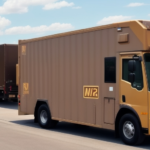Importance of Choosing the Right Delivery Carrier
Selecting the appropriate delivery carrier is crucial for the success of your business. The right carrier can influence customer satisfaction, shipping costs, and overall operational efficiency. According to a 2023 ShipScience report, businesses that optimize their delivery strategies experience a 20% increase in customer retention rates.
National vs. Local Delivery Services
Pros of National Delivery Services
National carriers like UPS and FedEx offer extensive networks capable of handling a wide range of shipping needs, from ground to air and international deliveries. They provide advanced tracking systems, ensuring both businesses and customers can monitor shipments in real-time.
- Wide range of shipping options, including overnight and international delivery
- Advanced tracking and notification systems
- Reliable infrastructure and consistent delivery times
Cons of National Delivery Services
While national carriers offer extensive services, they can be more expensive compared to local options. Additionally, their broad operational scope may lead to less personalized service and limited adaptability to regional nuances.
- Higher shipping costs
- Less personalized customer service
- Potentially slower response to regional issues
Benefits of Local Delivery Services
Local carriers provide tailored services with a deep understanding of regional logistics. They often offer more competitive pricing for nearby deliveries and personalized customer interactions, which can enhance customer loyalty.
- Cost-effective for local and regional shipments
- Flexible delivery options, including same-day or next-day services
- Personalized customer service and specialized delivery requests
Challenges with Local Delivery Services
While local carriers excel in certain areas, their limited network can be a drawback for businesses looking to expand their reach. They may also lack advanced tracking systems, which could impact customer transparency and satisfaction.
- Restricted delivery network
- Potentially fewer technological integrations
- Limited scalability for growing businesses
Comparing Prices and Services of Popular Delivery Carriers
When selecting a delivery carrier, it's essential to compare prices and services to find the best fit for your business. Carriers like USPS, DHL, and Amazon offer varying rates based on shipping speed, package size, weight, and destination. According to recent pricing data, USPS remains the most cost-effective for small packages, while DHL excels in international shipping.
- USPS: Best for small, light packages and domestic shipping.
- DHL: Superior for international shipments with robust global coverage.
- Amazon: Ideal for businesses integrated with Amazon's marketplace, offering competitive rates for high-volume shipments.
Additionally, consider value-added services such as insurance, tracking, and signature confirmation. These features can enhance customer trust and provide additional security for high-value or sensitive items.
Selecting the Best Delivery Carrier for Your Business
Your business size and specific shipping needs play a pivotal role in choosing the right delivery carrier. Small businesses might benefit from on-demand services like Postmates or DoorDash, which offer flexible delivery options. In contrast, larger enterprises may require comprehensive solutions such as freight shipping or international logistics support.
- Small Businesses: On-demand and same-day delivery services
- Medium to Large Businesses: Comprehensive logistics and international shipping
- Specialized Needs: Temperature-controlled shipping or heavy freight specialists
Consider the geographic location of your customer base. Partnering with a carrier that specializes in your primary regions can lead to cost savings and improved delivery times. Additionally, some carriers offer discounted rates for businesses with high shipping volumes, providing further financial benefits.
Negotiating Rates and Terms with Delivery Carriers
Negotiating favorable rates and terms with your delivery carrier can significantly reduce shipping costs. Larger shippers often have more leverage, but small businesses can also negotiate by leveraging loyalty and shipment volumes. According to industry standards, businesses can negotiate up to a 15% discount on standard rates with consistent shipping volumes.
- Discuss volume-based discounts
- Negotiate rates for specific shipping zones or types
- Seek flexible payment terms and delivery schedules
Be clear about your service requirements. If you need expedited or specialized services, be prepared to discuss premium rates. Understanding the carrier's pricing structure for different shipment types can also aid in securing the best deals.
Tracking and Monitoring Your Deliveries
Effective tracking and monitoring are essential for maintaining transparency and reliability in your shipping operations. Advanced tracking systems not only provide real-time updates to customers but also help businesses identify and address potential delays proactively. Implementing carriers that offer detailed tracking can enhance customer satisfaction and reduce the volume of delivery-related inquiries.
- Real-time tracking updates
- Automated notifications for shipping milestones
- Integration with business systems for seamless monitoring
Utilizing these tracking capabilities can lead to better inventory management and improved operational efficiency, ultimately contributing to a more streamlined shipping process.
Future Trends in the Delivery Industry
The delivery industry is rapidly evolving with technological advancements shaping the future of logistics. Innovations such as drone deliveries, autonomous vehicles, and robotic warehouses are set to revolutionize the way businesses handle shipping. Embracing these trends can provide a competitive advantage and enhance operational efficiency.
- Drone Deliveries: Faster delivery times and reduced labor costs.
- Autonomous Vehicles: Increased efficiency and extended delivery hours.
- Robotic Warehouses: Enhanced accuracy and speed in order fulfillment.
Moreover, sustainability remains a key focus, with many carriers investing in electric and hybrid vehicles to reduce carbon emissions. Adopting sustainable shipping practices can not only lower environmental impact but also appeal to environmentally conscious consumers.
Staying informed about these trends and adapting your shipping strategies accordingly will ensure that your business remains resilient and competitive in the ever-changing delivery landscape.
Conclusion
Choosing the right delivery carrier involves careful consideration of various factors, including cost, service quality, and operational needs. By evaluating the pros and cons of national and local carriers, comparing prices and services, and staying informed about industry trends, businesses can make informed decisions that enhance customer satisfaction and operational efficiency. For more insights and detailed analysis, visit ShipScience.




















